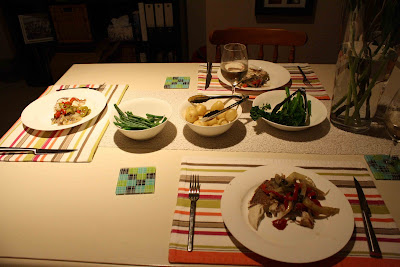Mum's place
There’s nothing like a good ol’ lamb shank with your dear ol’ mum, is there?
I’m not quite sure what it is about mums and slow cooking, but it’s all very comforting, and, perhaps combined with some sort of menstrual-related need for iron, I was craving a real fall-off-the-bone meat dish. So we went with this one:
Moroccan Lamb Shanks with Pumpkin and Sultanas
Serves 4
1 tablespoon olive oil
4 lamb shanks, French trimmed
2 medium onions, chopped
1 x 420 can chopped tomatoes
1 x thumb-sized piece ginger, grated
1 bunch coriander, chopped
½ cup water
1 tablespoon brown sugar
1 teaspoon ground cinnamon
1 teaspoon salt
1 cup (140g) sultanas
300g peeled pumpkin
Preheat oven to 180 degrees/160 fan forced.
Heat oil in a large pan. Add lamb shanks. Cook until well browned all over. Transfer lamb shanks to a tagine or ovenproof dish.
Add onions to the same pan, cook, stirring, until soft and golden.
Add tomatoes, ginger, coriander, water, brown sugar, cinnamon, salt and sultanas. Bring to the boil, then pour mixture over lamb shanks in dish.
Cover the dish and cook for 1 hour.
Cut pumpkin into chunky cubes. Remove lamb from oven; add pumpkin, cover and return to oven for another 30 minutes. Remove lid, cook for a further 30 minutes or until lamb is very tender.
**
We served it with minted, buttered couscous and steamed asparagus, which was just what we had on-hand.
I also made my favourite (and ridiculously easy) dolloping condiment: Tahini and yoghurt – simply mix equal-ish quantities of tahini and yoghurt and dollop on anything that resembles Middle-Eastern/North African fare. It’s simply delicious.
Mulberry-ade
I think my parents live in the most quintessential of suburban streets – in the old fashioned sense. All the neighbours know each other’s names, they talk to each other over the fence and they offer lemons and, in this instance, mulberries, from their over-abundant trees. Thanks to the very neighbourly “Pat”, for making this lovely pre-dinner refreshment possible.
2 cups mulberries, stalks removed
2 cups water (approx.)
½ cup sugar (approx – depends on how sweet you want them to be)
Soda water
Ice
Swizzle stick
Put the mulberries into a heavy-based saucepan and add enough water to just cover them. Sprinkle over the sugar and gently bring to a boil. Reduce heat and simmer for 30 minutes. Cool.
The fruit (and some of the juice*) can now be used as a base for pies, crumbles etc.
Fill tall glasses with ice. Extract a couple of tablespoons of the liquid per glass and top with soda water. Stir intermittently and thoughtfully with swizzle stick.
* NB – if you’re making a crumble, don’t do what I did and not include any liquid at the bottom of the pie dish. This made the crumble come out really dry and the fruit sticky. It needs to be moist!






































